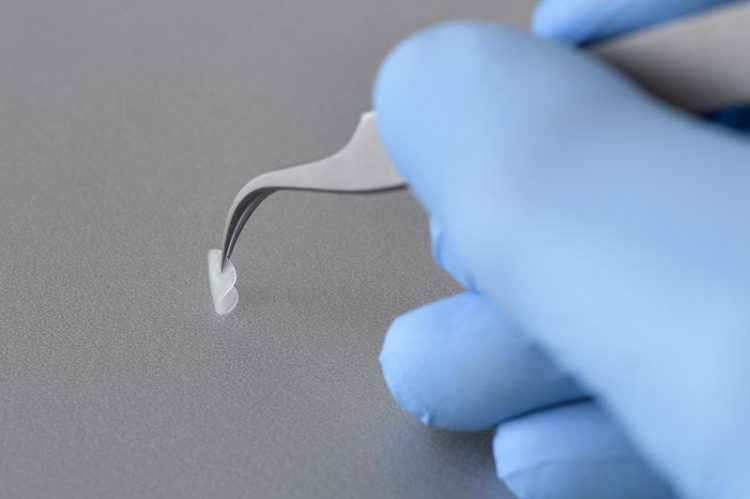Better healing for eardrum injuries? – new adhesive structures for medical applications

Innovative adhesive structures of the INM are examined for their medical suitability for eardrum injuries. Source: Iris Maurer; free within this press release
More than 30 million people worldwide suffer from eardrum injuries every year. If inadequately treated, the resulting hearing loss can severely restrict the patients' quality of life.
Smaller injuries can be treated by applying silicone or paper strips – larger cracks even require tissue transplantation. However, the tissues can slip.
Inflammation can lead to premature dissolution of the transplants or permanently impair the auditory canal as a result of scarring. Then, subsequent surgery becomes necessary, which puts the patient under renewed strain.
In cooperation with the Saarland University Hospital, the INM has developed bioinspired adhesive structures for the treatment of eardrum injuries. The adhesive structures are now to be transferred into a biomedical product.
“In a feasibility study with the University Hospital in Homburg, Germany, we tested our Gecko-inspired adhesive structures on ear drums of mice: They adhered reliably without peeling or slipping,” explains Eduard Arzt, head of the Functional Microstructures Program Division and Scientific Director at the INM.
“Thanks to the exceptional adhesive properties, the patch can be removed after successful healing without causing new injuries to the eardrum,” explains biologist Klaus Kruttwig. The gecko structures not only bridge the cracks, the micropattern is also expected to improve the healing process.
“The new material is soft and adaptable. It is easy and quick to apply to the eardrum. We expect that hospital stays will be significantly shorter and complications will be rarer,” said Professor Schick, Director of the Department of Otorhinolaryngology at the University Hospital. “We are therefore very confident that we will find a market for this product”.
For the next step, INM now received an ERC Proof of Concept Grant (PoC): The one-and-a-half year project STICK2HEAL serves to conduct technical and pre-clinical assessments and to prepare the approval of the adhesion structures as a medical product. In addition, potential markets for wound dressings are to be analysed and cooperation partners in industry and hospitals identified.
In addition to eardrum repair, the PoC project opens up a broad field of application when materials are to adhere to the body without glue for a limited period of time.
Background:
In 2013, Eduard Arzt received an Advanced Grant from the European Research Council (ERC) amounting to around 2.5 million euros. In recent years, Arzt and his team have developed three-dimensional structures and surfaces whose functions can be switched on and off by external stimuli. The results have been published in renowned scientific journals and protected by new patent families. After the first ERC Proof of Concept project SWITCH2MARKET was used to transfer the adhesive structures for robotics, STICK2HEAL now concentrates on biomedical applications. The University Hospital in Homburg is an essential cooperation partner. The project is funded by the European Research Council with around 150,000 euros.
Leibniz Institute for New Materials
Scientific Director and Chairman
Head Functional Microstructures
Phone. +49681-9300-500
eduard.arzt@leibniz-inm.de
Dr. Klaus Kruttwig
Leibniz Institute for New Materials
Head Biocompatible Structures
Phone: +49681-9300-145
klaus.kruttwig@leibniz-inm.de
Univ. – Prof. Dr. med. Bernhard Schick
Saarland University Hospital and Medical Faculty of Saarland University
Director of the Department of Otorhinolaryngology
Phone: +496841 – 16-22984
hno.chefsekretariat@uks.eu
Media Contact
More Information:
http://www.inm-gmbh.deAll latest news from the category: Life Sciences and Chemistry
Articles and reports from the Life Sciences and chemistry area deal with applied and basic research into modern biology, chemistry and human medicine.
Valuable information can be found on a range of life sciences fields including bacteriology, biochemistry, bionics, bioinformatics, biophysics, biotechnology, genetics, geobotany, human biology, marine biology, microbiology, molecular biology, cellular biology, zoology, bioinorganic chemistry, microchemistry and environmental chemistry.
Newest articles

Superradiant atoms could push the boundaries of how precisely time can be measured
Superradiant atoms can help us measure time more precisely than ever. In a new study, researchers from the University of Copenhagen present a new method for measuring the time interval,…

Ion thermoelectric conversion devices for near room temperature
The electrode sheet of the thermoelectric device consists of ionic hydrogel, which is sandwiched between the electrodes to form, and the Prussian blue on the electrode undergoes a redox reaction…

Zap Energy achieves 37-million-degree temperatures in a compact device
New publication reports record electron temperatures for a small-scale, sheared-flow-stabilized Z-pinch fusion device. In the nine decades since humans first produced fusion reactions, only a few fusion technologies have demonstrated…





















